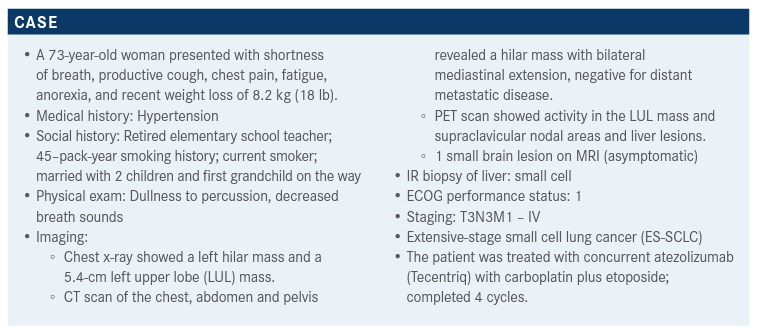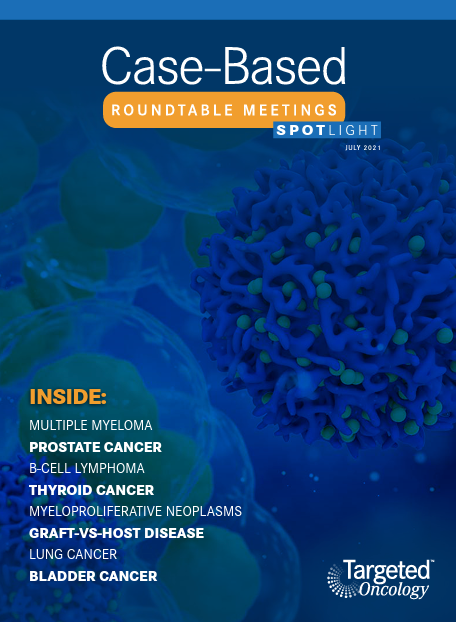The Impact of Immunotherapy Use in Small Cell Lung Cancer
During a Targeted Oncology Case-Based Roundtable event, Jarushka Naidoo, MB, BCh, MHS. discussed the case of a 73-year-old patient with small cell lung cancer who first presented with shortness of breath, productive cough, chest pain, and fatigue.
Jarushka Naidoo, MB, BCh, MHS

During a Targeted Oncology Case-Based Roundtable event, Jarushka Naidoo, MB, BCh, MHS, an assistant professor of Oncology at the Sidney Kimmel Comprehensive Cancer Centerat Johns Hopkins University, discussed the case of a 73-year-old patient with small cell lung cancer who first presented with shortness of breath, productive cough, chest pain, and fatigue.


Targeted OncologyTM: What factors influence your recommendation for treatment and counseling patients like this with the advent of immunotherapy? NAIDOO: Now [with] immunotherapy, the conversation involves maintenance immunotherapy after platinum doublet or in addition to the platinum doublet, so that certainly has affected my counseling of the patient regarding immunotherapy toxicities.
EFIOM-EKAHA: SCLC [small cell lung cancer] tends to have a lot of autoimmunity, with all the other paraneoplastic syndromes. I used to wonder if I was going to run into enhanced paraneoplastic syndromes that were prob-ably in the background, but maybe not symptomatic. And then, I throw the immune checkpoint inhibitor in and exacerbate some of that. But, I haven’t seen that, I’m not sure if any of that has been reported. I’m guessing if you treat the disease appropriately, they’ll get better, but I’d be interested to know what the response of the paraneoplastic syndromes would be, and if there’s any difference with a checkpoint inhibitor.
NAIDOO: My understanding is that this hasn’t really been reported. I know that in the original studies, anyone with a neurologic syndrome or any concern for autoimmunity would have been excluded.
So definitely, I think this is actually a gap in the data. I’m not sure that that has actually been reported in a real-life setting.
What do the guidelines recommend for treatment of SCLC?
NAIDOO: The NCCN [National Comprehensive Cancer Network] SCLC guidelines say that the preferred regimens would be [carboplatin plus etoposide (EP)] and atezolizumab [Tecentriq] followed by atezolizumab maintenance; carboplatin plus EP and durvalumab [Imfinzi], followed by durvalumab maintenance; or, cisplatin plus EP and durvalumab, followed by durvalumab maintenance.1 Other options could be withholding the immunotherapy, then [the regimen would be] either carboplatin plus EP or cisplatin plus EP; and, in certain circumstances, one may consider replacing the EP with irinotecan and either of the carboplatin or cisplatin backbones.
SHARMA: Would you use atezolizumab or durvalumab, or does it matter?
NAIDOO: The NCCN guidelines would say that the data are interchangeable.1 So, both are preferred regimens. The schedules are slightly different. The durvalumab could be given on a schedule that is slightly longer, [every 4 weeks]. Particularly in light of COVID-19, some feel that this may limit the number of visits patients may need to have, particularly in the maintenance setting. So, this may be a reason to consider that. However, atezolizumab was the first agent in this space to be FDA approved, but it is approved with a carboplatin backbone.2 So, if you wanted to give cisplatin, then durvalumab may be preferred.

What data support the addition of an immune checkpoint inhibitor to platinum plus EP chemotherapy?
NAIDOO: The [data from the] phase 3 IMpower133 study [NCT02763579] of carboplatin plus EP plus or minus atezolizumab [support this].3 This was published in the New England Journal of Medicine by Leora Horn, MD, MSc, and presented at ASCO [the American Society of Clinical Oncology Annual Meeting] that year by Stephen Liu, MD, our colleague from Georgetown. And just to recap, patients had ES-SCLC [extensive-stage small cell lung cancer] that was measurable, a performance status of 0 to 1 and no prior systemic therapy; asymptomatic brain metastases were allowed. Patients were randomized 1:1 to receive carboplatin plus EP and atezolizumab or carboplatin plus EP without the atezolizumab. Those who received atezolizumab also received atezolizumab maintenance until progression or loss of clinical benefit. The co-primary end points of this study were OS [overall survival] and PFS [progression-free survival].
This study was impressively positive. With a median follow-up of 13.9 months, we saw a benefit for both the OS and PFS that was statistically significant.3 [Atezolizumab plus carboplatin plus EP had an OS of 12.3 months vs carboplatin plus EP alone where the OS was 10.3 months.] So, an HR [hazard ratio] of 0.7 for OS, with an improvement in median survival of 2 months [95% CI, 0.54-0.91; P = .007]. [Atezolizumab plus carboplatin plus EP had a PFS of 5.2 months vs the PFS of carboplatin plus EP alone, which was 4.3 months.] An improvement in PFS of 1 month, with an HR of 0.77 [95% CI, 0.62-0.96; P = .02]. This is the first advance for systemic therapy in SCLC in over 30 years.
In terms of the 2-year OS follow-up, we see that this survival benefit was maintained.4 The HR was 0.76, and remained statistically significant, with a P value of .015 [95% CI, 0.60-0.95]. The benefit for the combination including atezolizumab [also] appeared to benefit nearly all subgroups. Although the confidence interval is particularly wide for patients with brain metastases, only a minority of patients who were enrolled had brain metastases [n = 35; HR, 0.96; 95% CI, 0.46-2.01]. It’s a relatively common thing to have in patients with SCLC, so [it is] difficult to interpret that. There was some analysis in patients who may have had TMB [tumor mutational burden] that was accessible. But this was only available in a minority of patients.
BHANDARI: Why are there 2 cutoffs in this study for TMB? One was 10, the other was 16.
NAIDOO: I can touch on that a little bit. The optimum cutoff for blood-based TMB [bTMB] is currently debated. As we know, a TMB of 10 is currently being used for tissue-based TMB as a potential cutoff to select high vs low.5 Sixteen was a cutoff that was used in the B-F1RST study and other studies based on bTMB.6 So, I think this highlights the fact that we don’t know what the optimum bTMB cutoff should be to identify a high TMB.
NAIDOO: [At 13.9 months in the IMpower133 trial], the objective response rate HR [in the atezolizumab arm] was 60.2% and [it was] 64.4% [in the placebo arm (atezolizumab, 95% CI, 53.1-67.0; placebo, 95% CI, 57.3-71.0)].3 A complete response rate was observed in 5 [patients in the atezolizumab arm] vs 2 [in the placebo arm (atezolizumab HR, 2.5; 95% CI, 0.8-5.7; placebo HR, 1.0; 95% CI, 0.1-3.5)]. Partial responses were seen in 116 patients [treated with atezolizumab] vs 128 [who received placebo [atezolizumab HR, 57.7; 95% CI, 50.6-64.6; placebo HR, 63.4; 95% CI, 56.3-70.0)]. The median duration of response was 4.2 months with atezolizumab vs 3.9 months with placebo. [Stable disease was present] in 42 [of the patients who received atezolizumab] vs 43 [who received placebo] [atezolizumab (HR, 20.9; 95% CI, 15.5-27.2; placebo (HR, 21.3; 95% CI, 15.9-27.6)]. Progressive disease [was present] in 22 [patients treated with atezolizumab] vs 14 [who received placebo (atezolizumab HR, 10.9; 95% CI, 7.0-16.1; placebo HR, 6.9; 95% CI, 3.8-11.4)]. [The number of patients] with an ongoing response at the 2-year followup was 11 [in the atezolizumab arm] and 3 [in the placebo arm], so, small numbers.4
Can you discuss some of the data on AEs (adverse events) in patients treated with atezolizumab?
NAIDOO: There was a reasonable rate of AEs, including high-grade AEs: 56.6% of patients in the atezolizumab arm had high-grade AEs compared with 56.1% of those in the placebo arm.3 The [data] are very similar between groups in that respect. The majority of toxicities really are consistent with chemotherapy toxicities: neutropenia, anemia, alopecia, nausea, and fatigue were the most common. [Let’s discuss the] CASPIAN study [NCT03043872], which also looked at patients with treatment-naive SCLC [and used an immune checkpoint inhibitor in addition to platinum plus EP chemotherapy].7 Similarly, [this study] allowed asymptomatic or treated stable brain metastases and [patients who had] measurable disease.
This was a slightly larger study, 805 patients, and it was a 3-arm randomized study, 1:1:1, comparing durvalumab plus tremelimumab plus platinum and EP vs durvalumab plus platinum and EP vs platinum and EP. Those who were treated with the immunotherapy combination could also receive maintenance immunotherapy until progression [of disease]. The primary end point of this study was OS; secondary end points were PFS, response rate, safety, and patient-reported outcomes.
This study also showed a benefit from its primary end point [at 25.1 months], with an improvement in the median OS of around 2.5 months, and an HR of 0.75 [95% CI, 0.620.91].8 The P value was statistically significant at .003. [Several of the] relevant subgroups of patients favored the combination that included durvalumab. But again, [there were] some small patient numbers, causing wide confidence intervals in certain subsets, such as those who were non-smokers, [and] those without liver metastases.
The updated PFS [at 12.9 months] compared the addition of immunotherapy to chemotherapy alone; [mean PFS for durvalumab plus platinum and EP was 5.1 months and 5.4 months for platinum and EP alone].8 Interestingly, the HR was 0.8, and these 2 [groups] were relatively similar [95% CI, 0.66-0.96]. But, in terms of a landmark PFS, we did see that this favored the addition of immunotherapy, with a 12-month PFS of 17.9 months, compared to 5.3 months. At 2 years, based on investigator assessment, we saw a PFS of 11 months [with immunotherapy], compared to 2.9 [without].
The objective response rate was 67.9% with the addition of immunotherapy compared to 58% for chemotherapy alone [odds ratio: 1.53; 95% CI, 1.08-2.18].9 The median duration of response was 5.1 months in both arms. Longer-term OS [is] similar to what we have seen with other immunotherapy studies, ie, with longer follow-up, we may see separation of the curves.8 And this leads to the hypothesis that sometimes immunotherapy may just take a while to work, [as we see in CASPIAN] with the 2-year OS rate of 23.4%, compared with 14.4% [in patients not receiving immunotherapy].
In terms of safety data, very similar again.9 The highgrade AEs, 70.3% with durvalumab plus tremelimumab plus platinum; 62.3% for durvalumab plus platinum and EP, and, 62.8% for the chemotherapy combination alone.
Can you speak to the similarities and differences in endpoints for the IMpower133 regimen vs the CASPIAN regimen?
NAIDOO: [Comparing] the IMpower133 regimen vs the CASPIAN regimen, we see that the controls are slightly different.3,4,7,8 One used 4 cycles of carboplatin and the other used 6 cycles and included either cisplatin or carboplatin.
The studies showed very similar benefits in OS. [The atezolizumab plus carboplatin plus EP regimen had an OS of 12.3 months, 10.3 months in the control group, and durvalumab plus platinum plus EP had an OS 12.9 months, 10.5 months in the control group.] Obviously, taking into account we never should do direct cross-trial comparisons, but very similar PFS. [The atezolizumab plus carboplatin plus EP regimen had a PFS of 5.2 months, 4.3 months in the control group, and the PFS for durvalumab plus platinum plus EP was 5.1 months, 5.4 months in the control group.] In terms of AEs, again, quite similar, in the 62% to 67% range, across the board for immunotherapy and the control groups. Objective response rates also ranging from 58% to 64%, 68% at the maximum.
What are some practical dosing and counseling considerations for the IMpower133 regimen and the CASPIAN regimen?
NAIDOO: The IMpower133 regimen uses carboplatin as its backbone; [with] the CASPIAN regimen, one can use either carboplatin or cisplatin. The dosage for [atezolizumab is 1200 mg every 3 weeks prior to chemotherapy; after 4 cycles of chemotherapy, atezolizumab as a single agent at 840 mg every 2 weeks, or 1200 mg every 3 weeks, or 1680 mg every 4 weeks.]10 The backbone of chemotherapy is 4 cycles [every 21 days] when we give durvalumab [and the dose is 1500 mg].11 We can then switch that to [durvalumab 1500 mg every 4 weeks as a single agent. As with other immunotherapies, we counsel our patients on immune-related AEs; the rare but occasional occurrence of infusion-related reactions can also be seen.10,11
REFERENCES:
1. NCCN Clinical Practice Guidelines in Oncology. Small Cell Lung Cancer, version 3.2021. Accessed June 26, 2021. https://bit.ly/3xAM9os
2. FDA approves atezolizumab for extensive-stage small cell lung cancer. News release. FDA Drug Approvals and Databases. March 19, 2019. Accessed June 26, 2021. https://bit.ly/3e3HcN5
3. Horn L, Mansfield AS, Szczęsna A, et al. First-line atezolizumab plus chemotherapy in extensive-stage small-cell lung cancer. N Engl J Med. 2018;379:22202229. doi:10.1056/NEJMoa1809064
4. Reck M, Liu SV, Mansfield AS, et al. 17360 - IMpower133: updated overall survival (OS) analysis of first-line (1L) atezolizumab (atezo) + carboplatin + etoposide in extensive-stage SCLC (ES-SCLC). Ann Oncol. 2019;30(suppl 5):v710-717. Accessed June 26, 2021. doi:10.1093/annonc/mdz264
5. Klempner SJ, Fabrizio D, Bane S, et al. Tumor Mutational Burden as a Predictive Biomarker for Response to Immune Checkpoint Inhibitors: A Review of Current Evidence. Oncologist. 2020;25(1):e147-e159. Accessed June 26, 2021. doi:10.1634/theoncologist.2019-0244
6. Socinski MA, Bondarenko I, Karaseva NA, et al. Weekly nab-paclitaxel in combination with carboplatin versus solvent-based paclitaxel plus carboplatin as first-line therapy in patients with advanced non-small-cell lung cancer: final results of a phase III trial. J Clin Oncol. 2012;30(17):2055-2062. doi:10.1200/JCO.2011.39.5848
7. Paz-Ares L, Dvorkin M, Chen Y, et al. Durvalumab plus platinum– etoposide versus platinum–etoposide in first-line treatment of extensivestage small-cell lung cancer (CASPIAN): a randomised, controlled, openlabel, phase 3 trial. Lancet. 2019;394(10212):1929-1939. doi:10.1016/ S0140-6736(19)32222
8. Goldman JW, Dvorkin M, Chen Y, et al. Durvalumab, with or without tremelimumab, plus platinum–etoposide versus platinum–etoposide alone in firstline treatment of extensive-stage small-cell lung cancer (CASPIAN): updated results from a randomised, controlled, open-label, phase 3 trial. Lancet Oncol. 2021;22(1):51-65. doi:10.1016/S0140-2045(20)30539-8
9. Paz-Ares L, Dvorkin M, Chen Y, et al. 9002 - Durvalumab ± tremelimumab + platinum-etoposide in first-line extensive-stage SCLC (ES-SCLC): Updated results from the phase III CASPIAN study. J Clin Oncol. 2020;38(suppl 15). doi:10.1200/JCO.2020.38.15_suppl.9002
10. Tecentriq. Prescribing information. Genentech, Inc; 2021. Accessed June 27, 2021. https://bit.ly/3h1XLLf
11. Imfinzi. Prescribing information. AstraZeneca Pharmaceuticals LP; 2021. Accessed June 27, 2021. https://bit.ly/3vXfIz3

Bispecific Antibodies and ADCs Deliver a Futuristic Horizon Across Lung Cancer Settings
October 23rd 2024Recent advancements in protein engineering, especially antibody-drug conjugates, show promise in lung cancer treatment, with ivonescimab outperforming pembrolizumab in PD-L1-positive advanced non-small cell lung cancer.
Read More